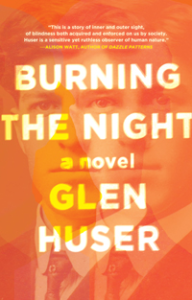Burning The Night – About The Book
 Books | About the Book | Synopsis | Questions & Activities
Books | About the Book | Synopsis | Questions & Activities
Burning the Night is a narrative that developed from an abiding interest I have in the history of Canadian art (especially the art of Tom Thompson and the work of the Group of Seven), and the Canadian homefront during World War I. The novel is shaped as well by my own experiences of becoming an artist and a teacher in the 1960’s.
In Burning the Night, first-person narrator, Curtis, tells the story of his relationship with Aunt Harriet, a blind woman who was married to Curtis’s uncle, Hartley Coleman. Curtis controls the tale by retelling Harriet’s story and that of her lover, an artist who lived and studied during World War I just as the Group of Seven was beginning to form. As Curtis tells her tale and reads Phillip’s diary, he reviews a period in his life when he struggled with shyness and confusion about his own sexuality.
Like an exercise Curtis assigns to his high school art class, Curtis can be focused on negative space—often looking for, longing for what is not there. His closest friend, Walter, a buddy from his university days and, later, a fellow teacher in Edmonton, is gay. Their closeness becomes increasingly evident as the story unfolds, but Curtis, like Aunt Harriet, can sometimes be blind.
When Curtis reveals to Walter that a chunk of Phillip’s diary has been excised, Walter begins to suspect that Phillip had some gay encounters himself—a supposition that Curtis, at first, scoffs at. But with trips to Toronto where Phillip studied art and briefly belonged to a men’s club of artists and photographers, evidence comes into play that Walter may well be correct.
The main characters in Burning the Night form a quadrangle that crosses gender and generations—intersections that play out across Canadian cities from Vancouver to Halifax, with much of the story occurring in Edmonton. Narrative currents cross and mingle as Curtis reads Phillip’s journal entries to Harriet. Although she is the subject of much of what Phillip writes, Curtis quickly becomes absorbed by the interior life of the man in the diary, someone who died 25 years before he was born. Through reading, re-reading, and even retracing Phillip’s steps, Curtis explores (avoids?) the figure and the landscape of his own character by exploring the abbreviated life of an artist and his lover.
While the great tragedy in Harriet’s life, the Halifax explosion of 1917, is an informing incident, the narrative in Burning the Night is built in such a way that the explosion is revealed climactically in closing chapters. Blinded and in a mental ward, Harriet is able, with time, to piece together a life of reclaimed stability with Hartley Coleman, a returned soldier, a life in which facts from that nightmarish time merge into a living fantasy—something Curtis discovers as the book ends.
I believe Burning the Night will appeal to readers of historical fiction (particularly Canadian historical fiction) as well as those who like fictionalized gay memoir.
